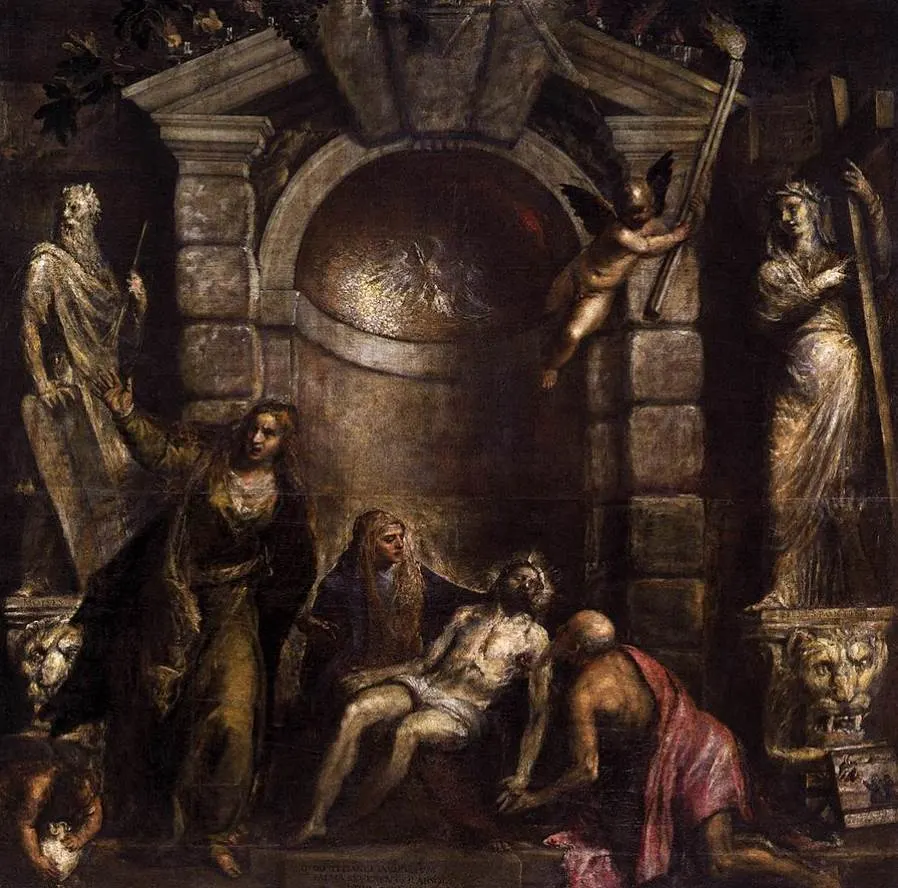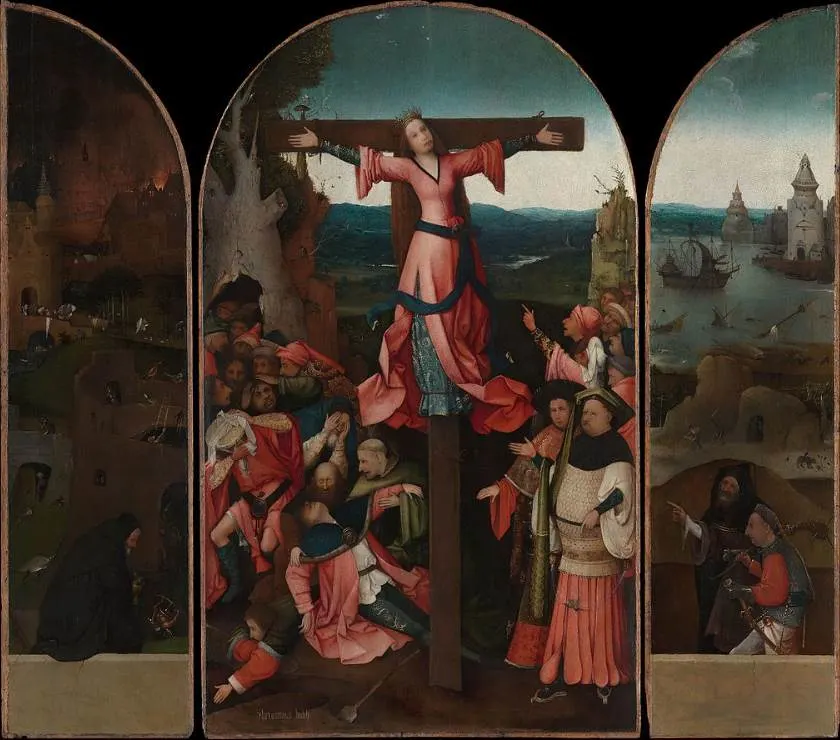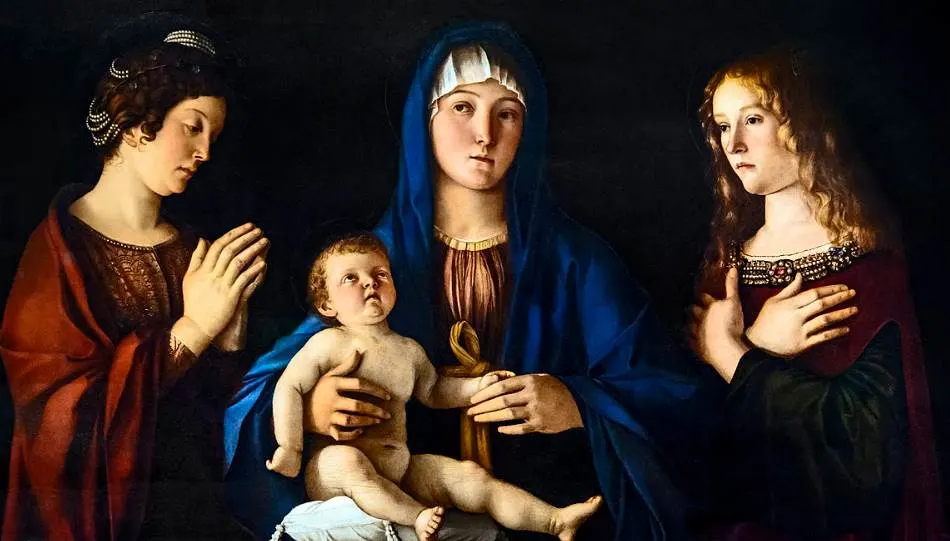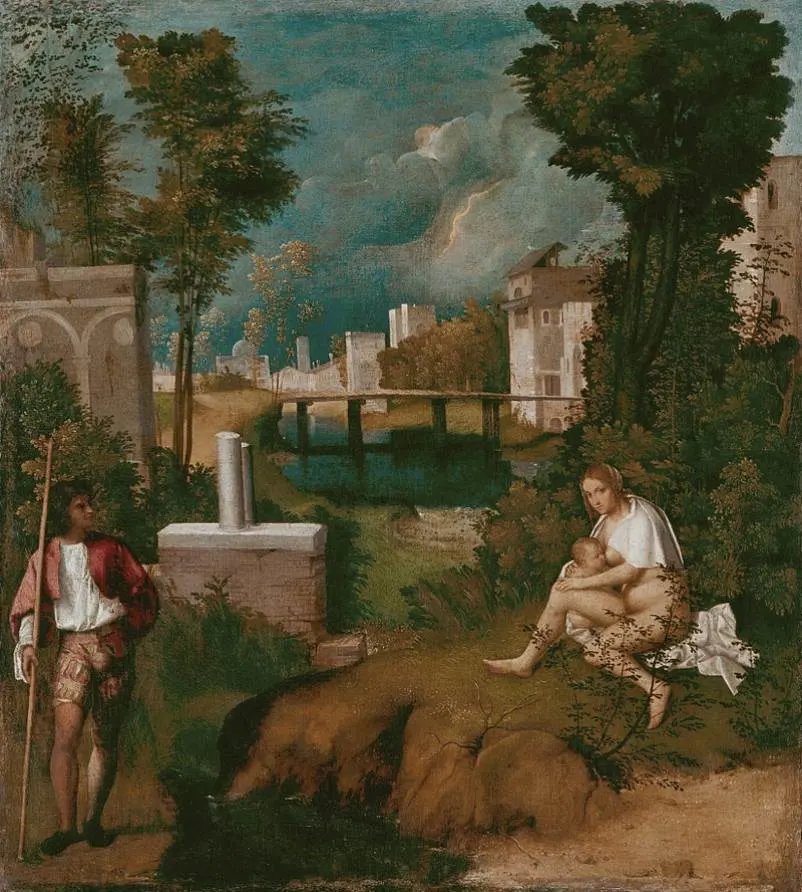One of the most famous museums in Venice was originally part of the art academy in the city. That’s why the museum’s façade bears the name of this institution.
The art academy and its Gallerie dell’Accademia were established in 1750 and are located in a remarkable building in Venice called the Scuola della Carità.
It can be found on the south bank of the city’s Grand Canal, just near the Ponte dell’Accademia, a bridge in Venice that is a popular spot to take pictures.
The museum houses an extensive collection of fine art produced by the Old Masters before the 19th century.
Unfortunately, the famous Vitruvian Man by Leonardo da Vinci (1452-1519) is part of the collection but not on public display due to its fragile nature.
Don’t worry because this list of famous paintings at the Gallerie dell’Accademia in Venice features plenty of incredible masterpieces.
1. The Feast in the House of Levi – Paolo Veronese
- Date created: 1573
- Dimensions: 560 × 1,309 centimeters (18.37 × 42.95 feet)
The Feast in the House of Levi is a monumental work of art painted by Venetian master of the Mannerist era (Late Renaissance) Paolo Veronese (1528-1588). It was commissioned to decorate the refectory of the Basilica di Santi Giovanni e Paolo in the northern part of Venice.
This immense Veronese painting was intended to become a Last Supper painting, but the Italian artist ended up being persecuted by the local Inquisition. The reason? The copious amounts of dubious content that he included such as drunkards and monkeys. He eventually changed the name and that solved the problem.

2. Miracle of the Slave – Tintoretto
- Date created: 1548
- Dimensions: 416 × 544 centimeters (164 × 214 inches)
Miracle of the Slave is another monumental painting at the Gallerie dell’Accademia (and it’s not the last) that was painted by the Venetian artist Jacopo Robusti (1518-1594) or “Tintoretto.” He was nicknamed “Il Furioso” because of the fierce painting technique he used that allowed him to paint at an incredible pace.

It was commissioned to decorate a remarkable Renaissance building in Venice called the Scuola Grande di San Marco. It was one of the first major commissions for the artist and is considered to be the world that established his reputation in the city. It depicts an episode in the life of Saint Mark, a common theme in paintings by Tintoretto.

3. Pietà – Titian
- Date created: 1575-1576
- Dimensions: 389 × 351 centimeters (153 × 138 inches)
The Pietà is one of the final paintings by Titian, the Venetian master who is considered to be one of the greatest Renaissance artists of the 16th century. It was incomplete at the time of his death in 1576 and one of his assistants completed the extension of the work.
Tiziano Vecelli (1488-1576) had intended the painting to be placed above his tomb in a Venetian church. Mary mourning the dead body of her son Jesus Christ was a popular subject for this purpose. The distinctive dark style marked the final period of the artist’s life which began around 1570.

4. Procession in St. Mark’s Square – Gentile Bellini
- Date created: 1496
- Dimensions: 347 × 770 centimeters (137 × 300 inches)
Procession in St. Mark’s Square is yet another monumental painting that depicts a scene taking place in the city of Venice. Here we can see a procession taking place in the main square of the city and a view of St. Mark’s Cathedral, the magnificent Italian Gothic church that was influenced by Byzantine architecture.
The painting was commissioned to decorate the main hall of the Scuola Grande di San Giovanni Evangelista, a building that has served as the seat of the eponymous brotherhood in Venice since the 13th century. The depicted event took place 50 years before the painting was completed and shows members of this brotherhood.

5. Miracle of the Relic of the Cross at the Ponte di Rialto – Vittore Carpaccio
- Date created: 1496
- Dimensions: 371 × 392 centimeters (146 × 154 inches)
Miracle of the Relic of the Cross at the Ponte di Rialto is a painting by Renaissance artist Vittore Carpaccio (1465-1526). It was commissioned by the same brotherhood as the Procession in St. Mark’s Square and for the same purpose as well which was to decorate the main hall of the brotherhood’s headquarters.
It’s one of 9 paintings commissioned for this purpose and depicts a miracle that supposedly happened through the relic of the Holy Cross. It depicts the story of a madman who was healed, an event that took place near the famous Rialto Bridge in the city. As you can see, it was still the medieval wooden bridge back then, not the white marble bridge that was completed between 1588 and 1591.

6. The Crucifixion of Saint Julia – Hieronymus Bosch
- Date created: 1497
- Dimensions: 104 × 119 centimeters (41 × 47 inches)
The Crucifixion of Saint Julia is also known as The Crucifixion of Saint Wilgefortis and is one of the remarkable paintings by Hieronymus Bosch. The Early Netherlandish artist is world-famous for his fantastical paintings.
This painting was initially believed to depict Saint Julia of Corsica but has later been identified as Saint Wilgefortis, a saint known as Saint Uncumber in England and Saint Liberata in Italy. The painting hung for a long time at the Doge’s Palace in Venice before being moved to the Gallerie dell’Accademia.

7. Madonna and Child with Saint Catherine and Saint Mary Magdalene – Giovanni Bellini
- Date created: 1490
- Dimensions: 58 × 107 centimeters (23 × 42 inches)
Madonna and Child with Saint Catherine and Saint Mary Magdalene is also known as “Sacred Conversation” and is one of the many masterpieces by renowned Renaissance artist Giovanni Bellini (1430-1516). This Venetian artist was highly influential for other 16th-century painters in the city.
The painting was completed around 1490 and is one of the best examples of a particular genre of painting known as “sacra conversazione.” These works depict the Virgin Mary with her infant son Jesus Christ among saints in a rather informal setting.

8. The Presentation of the Ring – Paris Bordone
- Date created: 1534
- Dimensions: 370 x 301 centimeters (145.7 × 118.5 inches)
The Presentation of the Ring is one of the ultimate masterpieces by Venetian Renaissance artist Paris Bordone (1495–1570). The painting is also known as “The Fisherman Presenting the Ring to Doge Gradenigo” which explains the legend it depicts.
This legend takes place in 1340, a year that Venice was struck by a violent storm. Somehow, a gondolier found himself in the possession of the golden ring of Saint Mark. The painting depicts the moment that he presents it to Doge Gradenigo, the ruler of the Republic of Venice at the time.

9. The Tempest – Giorgione
- Date created: 1506-1508
- Dimensions: 83 × 73 centimeters (33 × 29 inches)
The Tempest is one of the few paintings that have been positively attributed to the Italian master Giorgio Barbarelli da Castelfranco (1477-1510), better known by his nickname Giorgione. It was commissioned by a Venetian nobleman named Gabriele Vendramin and completed shortly before the artist passed away.
Giorgione has always been a mysterious figure in the world of art, although he is credited with founding the Venetian School of Renaissance painting. Art historians are still debating what the true meaning of this work is. The title “The Gypsy Woman and the Soldier” explains the identity of the figures, but what they represent remains unknown.

10. Saint Mark’s Body Brought to Venice – Tintoretto
- Date created: 1562-1566
- Dimensions: 398 × 315 centimeters (157 × 124 inches)
Saint Mark’s Body Brought to Venice is also known as “The Abduction of the Body of Saint Mark” and is a typical Mannerist painting by Venetian master Tintoretto. It’s another in a series of paintings that depict a scene in the life of Saint Mark, the patron saint of the city of Venice.
It’s one of the paintings he completed in the 1560s to decorate the Sala Capitolare of the Scuola Grande di San Marco in the city. The painting is famous for its remarkable use of perspective and the fact that Tintoretto painted himself as the bearded man who stands next to the camel.

